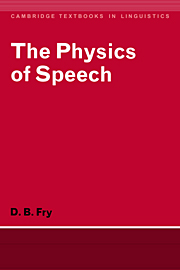Book contents
- Frontmatter
- Contents
- List of phonetic symbols
- 1 The speech chain
- 2 The generation of sound
- 3 The propagation of sound waves
- 4 Absorption and reflection of sound energy
- 5 Free and forced vibrations: resonance
- 6 The speech mechanism as sound generator
- 7 The vocal tract
- 8 Periodic and aperiodic sounds
- 9 Acoustic analysis: the sound spectrograph
- 10 Acoustic features of English sounds
- 11 Acoustic cues for the recognition of speech sounds
- Index
11 - Acoustic cues for the recognition of speech sounds
Published online by Cambridge University Press: 05 June 2012
- Frontmatter
- Contents
- List of phonetic symbols
- 1 The speech chain
- 2 The generation of sound
- 3 The propagation of sound waves
- 4 Absorption and reflection of sound energy
- 5 Free and forced vibrations: resonance
- 6 The speech mechanism as sound generator
- 7 The vocal tract
- 8 Periodic and aperiodic sounds
- 9 Acoustic analysis: the sound spectrograph
- 10 Acoustic features of English sounds
- 11 Acoustic cues for the recognition of speech sounds
- Index
Summary
The point has been made several times that the sounds of speech are extremely variable, that is to say that when a number of different speakers utter the ‘same’ word, the sounds are acoustically different in many respects. In spite of this it is very rarely that we have any difficulty in recognizing a word spoken to us; as listeners we are very well practised in arriving at the right answer when taking in a message in the face of a wide range of variation in the acoustic signals. Two factors are mainly responsible for our ability to do this: first, whenever someone is talking to us, we have a very good idea of what to expect; from our knowledge of the language, of the person talking and of the general situation we are able to predict more or less the course the message will follow. This property of speech and of language which makes such prediction possible is referred to technically as redundancy. Spoken messages also show redundancy in the more everyday sense of the word, they contain a great deal more information than is really needed for the understanding of the message, and this is particularly true at the acoustic level. The sound waves reaching our ears contain frequencies from 30 to 10,000 Hz, they embody intensity variations over a range of 30 dB or more and changes in frequency and intensity are taking place many times a second.
- Type
- Chapter
- Information
- The Physics of Speech , pp. 129 - 142Publisher: Cambridge University PressPrint publication year: 1979

